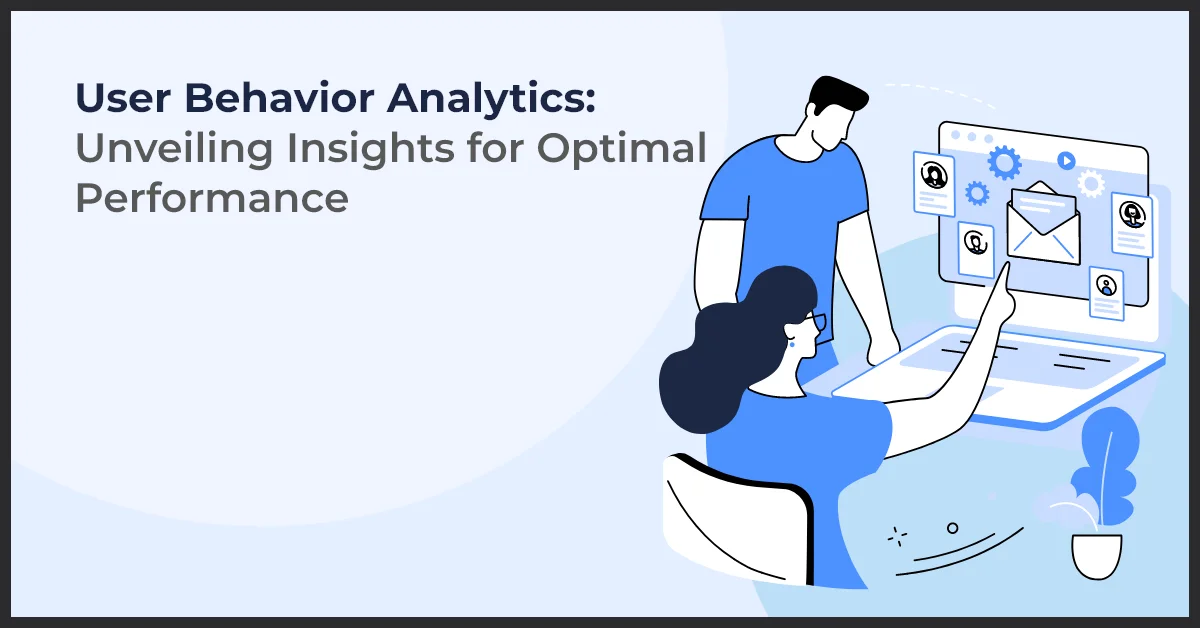User Behavior Analytics: Unveiling Insights for Optimal Performance

Published on: November 1, 2023
Updated on: October 10, 2024
3948 Views
- Analytics
12 min read
Understanding user behavior is a crucial aspect of any successful digital strategy. User Behavior Analytics (UBA) is a powerful methodology that provides invaluable insights into how users interact with your website or application. By analyzing user actions, preferences, and patterns, UBA allows businesses to make data-driven decisions that lead to improved user experience, increased conversions, and higher customer satisfaction.
Unveiling the intricacies of user behavior offers numerous benefits for businesses and marketers alike. It enables you to identify bottlenecks, optimize user journeys, and identify areas for improvement. By gaining a deep understanding of user preferences and motivations, you can tailor your products, services, and marketing efforts to meet their specific needs, thereby fostering stronger customer loyalty and brand advocacy.
Thanks to the advancements in technology, a wide range of user behavior analytics tools and applications are available to help businesses uncover valuable insights. These tools capture user interactions, track engagement, and offer visualizations that facilitate easy interpretation of complex data. From heatmaps and session recordings to funnel analysis and customer segmentation, UBA tools provide a comprehensive understanding of how users engage with your digital assets.
Whether you aim to optimize website performance, refine marketing strategies, or enhance user experience, user behavior analytics is an indispensable tool. In this guide, we will delve into the depths of user behavior analytics, exploring its definition, the importance of understanding user behavior, and the various tools and applications that can be utilized to unveil its secrets.
Understanding User Behavior
A. Behavior: The foundation of user behavior analytics
Behavior is at the core of user behavior analytics. It refers to the actions, choices, and decisions made by users while interacting with a particular system or platform. Understanding user behavior is crucial for businesses as it provides valuable insights into user preferences, patterns, and tendencies.
1. Definition and types of user behavior
User behavior can be classified into various types, including:
- Transactional behavior: This type of behavior focuses on users' purchasing habits, such as what products they buy, how often they make a purchase, and their average transaction value.
- Browsing behavior: Browsing behavior analyzes how users navigate through a website or app, what pages they visit, how much time they spend on each page and the actions they take while browsing.
- Clickstream behavior: Clickstream behavior tracks users' click paths, highlighting the sequence of pages visited, the links clicked, and the actions taken on each page.
2. Key components of behavior analysis
Behavior analysis involves examining various components to gain a comprehensive understanding of user behavior.
These components include:
- Frequency: The frequency at which users engage with a system or perform specific actions.
- Duration: The amount of time users spend on specific actions or within a system.
- Recency: How recently users have interacted with a system or performed specific actions.
- Intensity: The level of engagement or involvement users have in their interactions.
3. Role of behavioral economics and decision-making in user behavior analysis
Behavioral economics and decision-making play a crucial role in user behavior analysis. Understanding the psychological and cognitive factors that influence users' decisions and actions helps businesses optimize their products, services, and user experiences accordingly.
Pro Tip: Utilize tools that provide real-time analytics to track user actions as they happen. This allows for immediate insights into how users engage with your platform, enabling quick adjustments to enhance user experience.
B. User and Entity Behavior Analytics (UEBA)
1. Explanation of UEBA and its significance
User and Entity Behavior Analytics (UEBA) is an advanced approach to user behavior analysis. It focuses on monitoring and analyzing user behavior patterns, detecting anomalies, and identifying potential security threats or risks.
2. Differentiating user behavior analytics from entity behavior analytics
While user behavior analytics primarily focuses on individual users, entity behavior analytics extends its analysis to entities, such as accounts, systems, or devices. By analyzing both user and entity behavior, businesses gain a holistic view of potential security threats or risks.
3. Case studies highlighting the impact of UEBA on security and risk management
Various case studies have demonstrated the significant impact of UEBA on security and risk management. Implementing UEBA has helped organizations detect and prevent insider threats, identify unauthorized access or suspicious activities, and enhance overall security posture.
Pro Tip: Implement anomaly detection algorithms within your UEBA systems to identify unusual patterns that may indicate security threats. This proactive approach helps safeguard your business against potential risks and enhances overall security.
C. Users in User Behavior Analytics
1. Definition and characteristics of users in analytics
In user behavior analytics, users refer to individuals who interact with a system, website, or application. Users can be categorized based on various characteristics, such as demographics, preferences, behaviors, and engagement levels.
2. Importance of user segmentation for behavior analysis
User segmentation is crucial for behavior analysis as it helps businesses identify unique user groups and understand their specific behavior patterns. By segmenting users, businesses can personalize their strategies, offerings, and marketing campaigns to cater to different user segments effectively.
3. Customer segmentation for personalized insights and recommendations
Customer segmentation takes user segmentation a step further by considering additional factors such as purchase history, preferences, and browsing behavior. This deeper segmentation allows businesses to provide personalized insights, recommendations, and experiences to individual customers.
Data Analysis and Insights
In order to truly understand user behavior and make informed decisions, it is essential to analyze and extract insights from the data gathered. By leveraging user behavior analytics, businesses can gain valuable knowledge about their customers and optimize their strategies accordingly.
A. Analytics for User Behavior
- Overview of analytics methods and techniques: There are various methods and techniques used in user behavior analytics, such as qualitative and quantitative analysis, cohort analysis, and event tracking. These approaches help in understanding user actions, preferences, and trends.
- Role of machine learning and predictive analytics in analyzing user behavior: Machine learning algorithms and predictive analytics models can be applied to user behavior data to uncover patterns and predict future actions. By analyzing past behavior, businesses can anticipate user needs and tailor their offerings accordingly.
- Importance of A/B testing in identifying behavioral patterns: A/B testing involves experimenting with different versions of a website or application to determine which performs better in terms of user behavior. By testing different variations and analyzing the results, businesses can identify behavioral patterns and make data-driven decisions.
B. Leveraging Data for Insights
- Extracting valuable insights from user behavior data: User behavior data holds immense potential for extracting valuable insights. By analyzing this data, businesses can identify trends, preferences, and pain points of their users. These insights can guide product development, marketing strategies, and customer experience improvements.
- How to visualize and communicate insights effectively: Visualizing data in a clear and meaningful way is crucial for effective communication of insights. Through data visualization techniques, businesses can present complex user behavior data in a visually appealing and easy-to-understand format.
- Case studies showcasing successful data-driven insights application: To demonstrate the power of data-driven insights, case studies can be analyzed. These real-world examples illustrate how businesses have successfully utilized user behavior analytics to drive their strategies and achieve desired outcomes.
Pro Tip: Regularly conduct A/B testing on different user experiences to understand what resonates most with your audience. You can optimize your offerings for maximum engagement and conversions by experimenting with various elements and analyzing user responses.
Tools and Applications for User Behavior Analytics
Understanding user behavior is crucial for businesses looking to improve their online presence and enhance customer experiences. With the advancement in technology, there are now a variety of tools available for user behavior analytics. These tools are designed to help businesses collect and analyze data to gain valuable insights into user behavior. In this section, we will explore an overview of user behavior analytics tools, key features, and functionalities of top tools, and how to compare and evaluate different tools based on specific business needs.
A. Overview of User Behavior Analytics Tools
1. Popular tools for data collection and analysis:
- Google Analytics: A widely used tool that provides comprehensive data on website traffic, user engagement, and conversions. It offers detailed reports and real-time analytics.
- Hotjar: This tool combines heatmaps, user session recordings, and feedback polls to provide insights into user behavior. It helps identify website usability issues and areas of improvement.
- Mouseflow: Mouseflow offers session replay, heatmaps, and conversion funnels. It provides valuable insights into user behavior and helps optimize website performance.
2. Key features and functionalities of top user behavior analytics tools:
- Heatmaps: These visual representations of user activity on a website help businesses identify popular areas, scroll depth, and click patterns.
- Session recordings: Tools that offer session recordings enable businesses to watch and analyze user interactions on their websites, helping uncover pain points and areas for improvement.
- Conversion funnels: These tools track user journeys from entry to conversion, allowing businesses to understand where users drop off and optimize their conversion rates.
3. Comparison and evaluation of different tools based on specific business needs:
- Businesses should consider factors such as cost, ease of use, scalability, integration with existing systems, and customer support when evaluating user behavior analytics tools.
- It is important to align the tool's features and functionalities with the specific goals and requirements of the business.
- By comparing and evaluating different tools, businesses can choose the most suitable one for their user behavior analytics needs.
B. Applying User Behavior Analytics
1. User journey mapping for behavioral understanding:
- User journey mapping involves visualizing and understanding the steps a user takes on a website or app, helping businesses identify pain points and optimize user experiences.
- By analyzing user behavior and identifying common paths, businesses can tailor their content and website structure to improve engagement and conversions.
2. Conversion rate optimization through user behavior analysis:
- User behavior analytics tools can track user interactions and identify barriers that hinder conversions.
- By analyzing user behavior data, businesses can make data-driven changes to their website design, layout, and content to enhance the conversion rate.
3. Improving website traffic and user engagement using behavioral insights:
- Behavioral insights from user behavior analytics tools can help businesses understand what drives traffic and engagement on their websites.
- Businesses can then optimize their marketing strategies and website content to attract and retain more visitors, resulting in increased traffic and user engagement.
Privacy and Ethical Considerations
Protecting user privacy and ensuring ethical practices are followed is paramount when using user behavior analytics. As valuable as the insights gained from analyzing user behavior may be, it is crucial to prioritize privacy considerations and adhere to ethical guidelines.
Data Privacy and User Behavior Analytics
Understanding data privacy regulations and compliance is essential when working with user behavior analytics. Companies must familiarize themselves with applicable laws, such as the General Data Protection Regulation (GDPR) in Europe or the California Consumer Privacy Act (CCPA) in the United States.
When implementing user behavior analytics, it is necessary to obtain explicit consent from users before collecting any personal data. The collection, storage, and processing of data should be kept secure and comply with relevant regulations.
Best Practices for Ethical Data Collection and Analysis
Ethics play a crucial role in the responsible use of user behavior analytics. Implementing best practices ensures that users' trust is maintained, and their data is treated with respect and transparency.
Some key practices to consider include anonymizing and aggregating data to protect individual identities, as well as providing clear opt-out mechanisms for users who do not wish to participate in data collection.
It is essential to only collect data that is relevant to the insights being sought and to minimize the data collected to avoid any unnecessary invasion of privacy. Regularly reviewing and updating data collection and analysis practices can help maintain ethical standards.
Balancing Privacy Concerns with the Benefits of User Behavior Analytics
While privacy concerns must be addressed, it is crucial to recognize the benefits that user behavior analytics can bring to businesses and users alike. By analyzing user behavior, companies can improve their products and services to better meet customer needs.
Transparency and communication with users about how their data is being used can help alleviate concerns and build trust. Implementing robust data protection measures and adhering to ethical guidelines can strike a balance between using user behavior analytics effectively and respecting user privacy.
Key Takeaways
- Understanding user behavior analytics is vital for businesses to improve user experience and drive conversions.
- Utilizing behavioral insights helps identify pain points in user journeys, enabling businesses to optimize their strategies.
- User segmentation enhances the ability to tailor marketing efforts and services based on unique user characteristics.
- Data visualization plays a significant role in effectively communicating insights derived from user behavior analytics.
- Balancing data privacy and ethical considerations is essential to maintain user trust while leveraging analytics for business growth.
Conclusion
User Behavior Analytics is a powerful tool for businesses to gain valuable insights into their customers' behavior and preferences. By understanding how users interact with their websites, applications, and products, businesses can make data-driven decisions and improve user experiences.
Throughout this article series, we have explored the fundamentals of user behavior analytics, including understanding user behavior, data analysis, tools and applications, and privacy considerations. We have seen how businesses can leverage these analytics to make informed decisions and drive success.
Future trends and developments in the field
The field of user behavior analytics is constantly evolving. As technology advances and new data sources become available, businesses can expect even more sophisticated analytics tools and techniques. Machine learning and artificial intelligence will play a crucial role in uncovering hidden insights and predicting user behavior.
Final thoughts on leveraging user behavior analytics for business success
User behavior analytics has become an essential component of business strategies across various industries. It offers invaluable insights that drive customer-centric decision-making and ultimately lead to business success. By leveraging user behavior analytics, businesses can stay ahead of the competition, enhance user experiences, and maximize their return on investment.
In conclusion, user behavior analytics is a powerful tool that businesses should embrace to understand their customers better and optimize their strategies. By harnessing the potential of data analysis and insights, businesses can gain a competitive edge and thrive in today's data-driven world.
Frequently Asked Questions
User behavior analytics involves analyzing data on how users interact with a website or application, including their actions, patterns, and preferences, to understand and improve their overall experience.
User behavior analytics is important because it provides insights into user needs, preferences, and pain points, enabling businesses to optimize their platforms, enhance user experience, and make data-driven decisions.
User behavior insights can improve user experience by identifying friction points, understanding user preferences, and guiding design and functionality improvements that lead to more intuitive and satisfying interactions.
Best practices include defining goals, segmenting user data, regularly reviewing and interpreting data, integrating insights into design and strategy, and ensuring data privacy and security.
Data collected includes page views, click patterns, session duration, navigation paths, user interactions, bounce rates, conversion rates, and demographic information, among other user activities.



